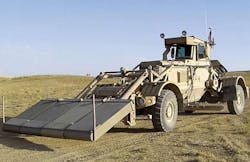Army to oversee development of ground-penetrating radar that works in real time at tactical speeds
Officials of the Army Contracting Command in Alexandria, Va., announced a $7.3 million contract Thursday to Non-Intrusive Technology Inc.(NIITEK) in Dulles, Va., to develop a real-time version of the company's ground-penetrating radar.
The contract calls for NIITEK to develop enhanced downward-looking ground-penetrating radar technologies for real time detection of buried antitank landmines and improvised explosive devices (IEDs) from ground based vehicles moving at tactical speeds in support of route clearance missions.
Route clearance is critical to the Army's combat and logistics supply capability, Army researchers point out. Downward-looking ground-penetrating radar technology, such as the one in the NIITEK Husky Mounted Detection System (HMDS), provides a counter-IED system that can detect underbelly IEDs and antitank landmines buried in primary and secondary roads.
Related: Army ground-penetrating radar program moves forward; NIITEK to provide test IED sensors
HMDS uses an advanced, high-performance ground-penetrating radar to detect both non-metallic and metal-cased buried threats, including IEDs constructed of bulk explosives and low-metal pressure plates.
Current HMDS performance is limited by the ability of the ground-penetrating radar to detect targets deeply enough to find them all. The system also must operate relatively far away from sources of potential electromagnetic interference such as electronic jammers.
The contract calls for NIITEK to pursue advanced technologies that will address these performance limitations. The Army Contracting Command awarded the contract on behalf of the Army Night Vision & Electronic Sensors Directorate (NVESD) at Fort Belvoir, Va.
NIITEK has been developing ground-penetrating radar technology to detect buried explosives since 2006. Army officials awarded this contract to NIITEK sole-source because they consider the company to be the only responsible source of the work that needs to be done.
The NIITEK HMDS ground-penetrating radar is becoming an Army program of record. It is a combination of the NIITEK VISOR 2500 ground-penetrating radar and the Husky vehicle from Critical Solutions International Inc. in Carrollton, Texas.
The HMDS helps the Army quickly clear roadways of anti-tank mines, roadside bombs, and other IEDs. It combines advanced real-time automatic-target-recognition algorithms, integrated metallic and non-metallic threat detection, automatic precision marking, and software in a ruggedized, supportable package.
The system uses ultra-wide-bandwidth impulses, has a high signal to clutter ratio, low radar cross-section, is lightweight, and offers low power consumption, NIITEK officials say.
Related: Curtiss-Wright to deliver U.S. Army ground penetrating radar technology
NIITEK’s multi-panel high-performance VISOR ground-penetrating radar functions on manned blast-resistant vehicles to provide rapid ability to scope out anti-vehicle landmines and other explosive hazards on main supply routes and additional open areas as needed, NIITEK officials say.
NIITEK’s ground-penetrating radar and an optional metal detector, when mounted on manned, blast-resistant vehicles, provides a rapid ability to scope out anti-vehicular landmines or any other type of buried explosive hazard.
For more information contact NIITEK online at www.niitek.com, or the Army Night Vision and Electronic Sensors Directorate at www.cerdec.army.mil/inside_cerdec/nvesd.
